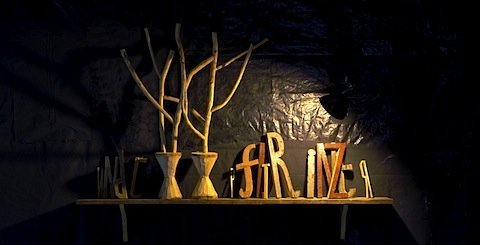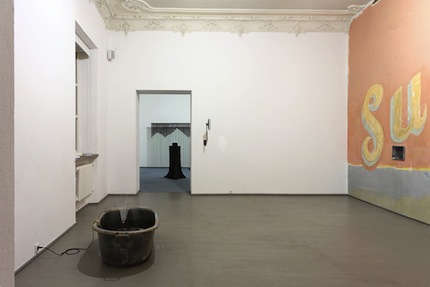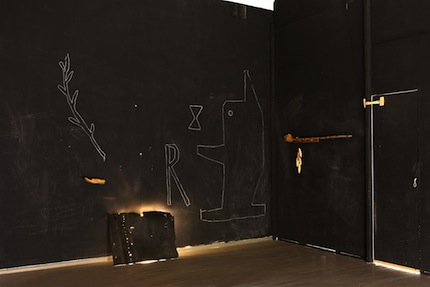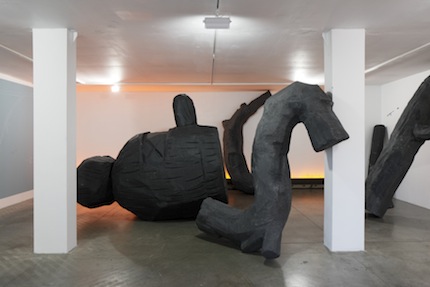
Something’s Hidden in the Woods There
19/12/2011
I arrived in Vilnius two weeks ago to see the internationally renowned Lithuanian curator Raimundas Malašauskas’s exhibit at the Contemporary Art Center and perhaps hear one of his equally famous stories. Yet in the end, without tasting the special cocktail at the opening, I instead wandered into the no-less-renowned artist Žilvinas Landzbergas’s (1979) solo show at the Vartai Gallery. At the show, I was shocked by not only his work Sunset, but also the artist’s own personality and my conversation with him, which brought feelings similar to those experienced upon opening a fairy tale book. And so there I remained.

Žilvinas Landzbergas in kim?. Photo: Ansis Starks
As a student at the Art Academy of Latvia, I took a course on Baltic art. I recall the division between the artistic medium most characteristic of each of these nations, in which each country feels the strongest. For example, Latvians have painting, Estonians have the graphic arts, and Lithuanians have sculpture. Though this is one of the classic constructs of Soviet art history, having grown out of the ideological foundation of art exhibits and institutions, it has been particularly sustainable until now. I too have always thought that, thanks to Lithuania’s marked Baroque heritage and Catholic influences, their visual art traditions possess a particularly spatial sense directed toward expressivity and character, a robustness and roughness of form mixed with the presence of powerful emotions. Landzbergas’s works also speak of the birth of myth and imagination’s creation of reality, in both of his almost simultaneous exhibits: For Ever Again at the Kim? Contemporary Art Center’s VKN Gallery in Riga (on display through December 11) and at the Vartai Gallery in Vilnius (through January 7).
In honor of its twentieth anniversary, the Vartai Gallery’s unique space, still filled with nineteenth-century architectural artifacts, is hosting works by Žilvinas—Sunset and The Future is Now—and objects by Spanish artist Jaime Pitarch. During our conversation, Žilvinas called the exhibit For Ever Again, on display at the Kim? VKN Gallery, a sort of continuation of the works displayed at Vartai, though the Riga exhibit opened first.[1] Here I must add that For Ever Again continued a thematic series of exhibits/objects begun this year in Vienna as part of the exhibit The Future is Now. Continuity is an important aspect of the artist’s work, because the objects or groups of objects displayed at one exhibit can “participate” in another, yet in completely different combinations or relationships, depending on the space and compositional plans. As mentioned in the introductory text to For Ever Again, a space actively changes and the characteristics of a place determine the choice of displayed objects and the way they are exhibited.[2]Both exhibits differ from one another in the way that the space is inhabited and how a dialogue is formed with it. When viewed together, they definitely express more about the artist and the principles of his work than each individually. For example, the exhibit at Vartai, which inhabits two large spaces, creating within them installations and objects of various scales and forms, is in a structural sense much more organically and freely created than the exhibit at the VKN Gallery.


Exposition sight in Vartai, Vilnius
This can also be explained by the character of the space, its requirements, and the corresponding adaptation or rejection of the work of art from it. Vartai is not a white cube; the decorative plaster ornaments have been preserved in the high ceiling, as have the spatial plan and old windows. This endows the space with a historically saturated atmosphere, and gives Žilvinas’s semantically layered works a place for discussion and expansion. Yet the show at the VKN Gallery left a slightly synthetic character, becoming completed and overly sterile, conforming to its discursive, neo-conceptualist format. At the same time, in terms of its imagery and the effects of its wide ranging scope, the exhibit became an antithesis to VKN’s cultivated and sometimes overly self-serving style of activity.
Visitors to the Vartai Gallery are met with an enormous sign that says “Sunset,” diagonally painted in tasty peach and lemon tones across the wall like an advertising slogan. And it really does remind the viewer of a highlight from a roadside billboard, pointing to some hotel chain or a boat rental place with a dose of kitsch. The slogan calls to mind something seen in the movies, in the spirit of a trip to Las Vegas. This feeling is highlighted by the “champagne machine” set up under the “Sunset” sign, from which—at least according to Žilvinas—this sparkling beverage flowed during the opening of the show.


Exposition sight in Vartai, Vilnius
When you turn your gaze toward the “Sunset,” you hear behind your back the gurgling of a fountain made of a simple device generating water pressure, set up in an ordinary tub-like bath. This whole slightly “crooked mirror-world” is enhanced by a mirror affixed to the wall on the right, in which, thanks to its slanted positioning, it’s not possible to see yourself. In our conversation, Žilvinas called this a “spooky horror pop movie effect.”


Exposition sight in Vartai, Vilnius
I think nobody will deny that the nature of all the described objects already includes a significant dose of irony and clichéd references, and is semantically saturated enough to form a certain dose of references at least to Hollywood films. Thereby inconspicuously involving the viewer in the creation of meaning for the work of art. Yet to my mind, what’s essential in Žilvinas’s work is the attraction of the object itself, the ability to experience it variously and diversely, to recognize it as close and meaningful. For example, we associate the image of the sunset with such a banal landscape that it seems nauseating just to look at it; yet we don’t avoid doing so in real life, associating romantic moments with a sunset or yearning for one. The same can be said for the calming sound of the fountain, which in Žilvinas’s interpretation isn’t lofty or aesthetically enjoyable as an object at all, but rather more similar to trash.
I think that on the backdrop of today’s visual cultural layer, right here and now an (apathetic) drowning in nostalgia/melancholy is taking place—a desire to pull away from the possibly extant and real, an excitement over historical imitation, a desire for another (safer) world, or precisely the opposite: a sorrow for the departed. Žilvinas offers us to catch sight of this imitation, to look at it critically, to overcome the matter and the mythology of stories it carries. He is interested in how deep and true emotions or feelings, when repeated many times, transform and lose their initial power and essence. For example, as has happened to the infamous sunset.


Exposition sight in Vartai, Vilnius
Žilvinas possesses the ability to preserve a balance, some irony, and humor in everything. He is also able powerfully to structure objects spatially, allowing them to live their own live and transform (it doesn’t matter if there is no champagne left or if the fountain is littered on opening day with white disposable glasses), as well as to play with associations, simultaneously challenging and doubting them. The ability to recognize the boundary between an amateur, even childish infatuation and professionalism, knowing the right moment to stop and precisely capture a character’s points of influence, are confirmed by two objects of groups of objects from both the Vartai exhibit and the Kim? exhibit. The first is the sculptor’s room set up in the Vartai Gallery—a dark cell packed with various wooden objects. The “Sunset” slogan itself, where a door has been set up, leads visitors to the room. Along the wall are shelves holdings various small objects, which are stylistically reminiscent of birds or other animals, trees, and various other things. An illuminated table, piled with books that seem to have come from an antique shop, is placed along the central wall. It turns out that they, too, are made of wood, yet unlike the rest of the figures they leave the impression of very realistic form.

Exposition sight in Vartai, Vilnius
As Žilvinas himself jokes, this is God’s room. So, Sunset was just a pretext or a cover, in order to arrive in this, a place saturated with the objects’ “true” nature. This poses the question, What is what and why does it look like this? However, one doesn’t want to rush with an answer because a spatial experience comes to the forefront, arranged purely for the sense and vision. As if you had gone into the woods and it had suddenly seemed as if the trees had begun to speak or the roots acquired human facial features.
Here you sooner want to ask the question, Are we speaking about something absolutely existent, or nonetheless about something we have imaged and that mostly rests in our experience of viewed images and our imagination—why does that root look like a face? why does that stump look like a bird? This same questions is asked at the Kim? exhibit: Why does the composition of objects that inhabits the exhibition space and is seemingly confined there remind us of pieces of coal or burnt trees, encircling what looks like the form of a human figure lying down? What is my imagination doing, or what does Žilvinas want to incite in my imagination? Perhaps these are quests in search of a much more interesting space than the melancholy/nostalgia space, much more impressive, dynamic, and sustainable, constructed not from something nonexistent but from something existent—things and their meanings, which are found in constant flux.


Exposition sight in kim?, Riga. Photo: Ansis Starks
I think that the object built into the wall of the VKN Gallery should be considered a metaphor for an Other space. A palm-sized square opening leads the gaze into a miniature environment that looks like an exhibition hall; it is empty, with several rooms, illuminated with a bright white light, and the only objects arranged there are two small pyramids/cones. It doesn’t matter what this space is—the artist’s internal space (a self-portrait, in Žilvinas’s words) or the ideal space required by every artist to create words. This is a space that is missed and that is needed. Like any object by Žilvinas, found in a continual process, this miniature place was also intended differently, filled with something else, possibly differing in its message from the interpretation I offer. Yet may what was intended there remain as a secret until the artist’s next exhibit.